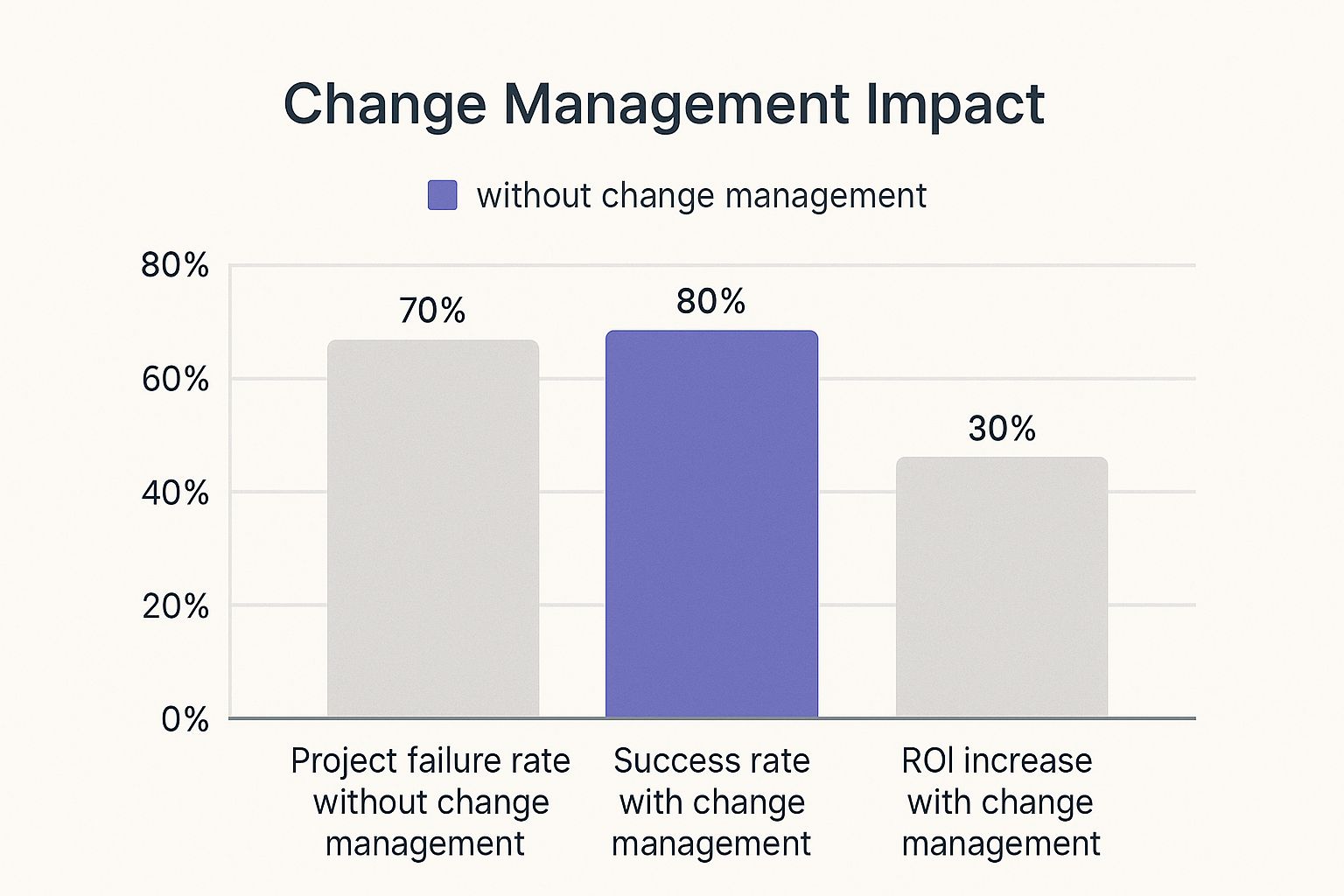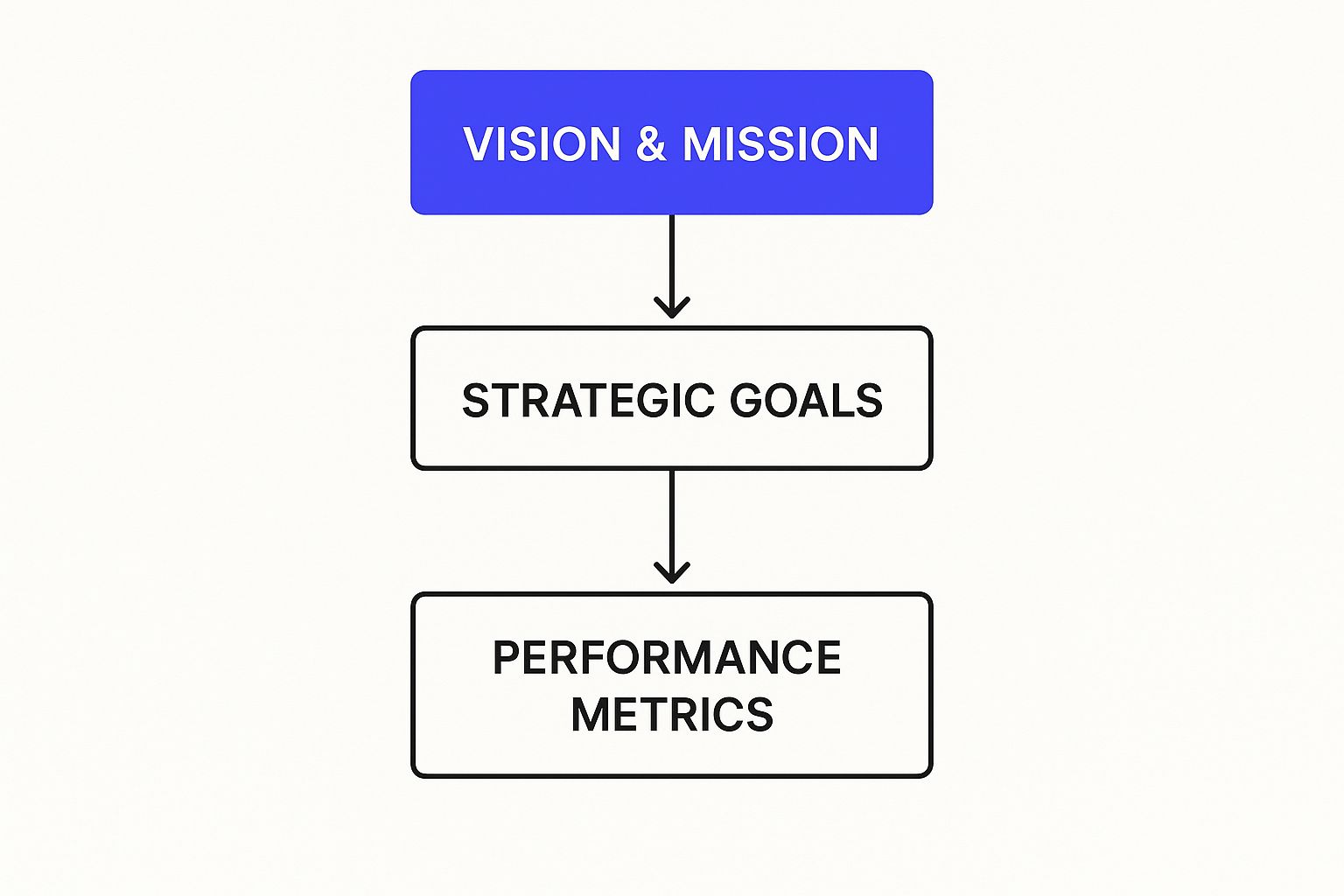Digital transformation is a term that gets thrown around a lot. It often sounds big, complicated and expensive. At its core, it is not about buying more technology. It is about rewiring how your organisation works to make it more open, capable and sustainable. To start, it is important to have a clear understanding of What Digital Transformation truly means beyond the usual buzzwords.
True transformation starts with people, not platforms. It is about cutting through the operational fog that holds your teams back and clarifying the path forward. The goal is to move from being busy to being effective. This shift empowers your teams, sharpens your decision-making and builds a more resilient business.
In this article, we will break down the practical, tangible benefits of digital transformation you can expect when you get it right. We will explore eight core outcomes, from enhancing operational efficiency to boosting competitive advantage. These are not just theoretical gains. They are real-world results we see when we partner with organisations to embed lasting change. Let’s explore what 'better' really means for your people, processes and bottom line.
1. Radically Improved Operational Efficiency
The first and most immediate of the benefits of digital transformation is often seen in how your organisation’s work gets done. By mapping core processes and applying smart automation, you eliminate the repetitive, manual tasks that drain your team’s energy and time. This is not about replacing people. It is about freeing them to focus on higher-value, strategic work.
We help clients connect disconnected systems and streamline critical workflows. This directly reduces errors, cuts waste and accelerates service delivery. The result is a calmer, more productive environment where operations flow smoothly. This streamlined process creates a powerful dividend in freed time, allowing your team to reclaim hours each week for innovation instead of administrative drag.
Putting efficiency into practice.
- Real-world example. A mid-sized logistics firm we worked with automated its entire dispatch process. This single change reduced vehicle scheduling time by 75% and eliminated costly human errors, improving both profit margins and customer satisfaction.
- Our approach. Yopla’s Plans Portal provides a central hub for communication and progress tracking. It removes the need for endless status update meetings, giving everyone a single, transparent view of project milestones and dependencies.
How to get started.
To begin realising this benefit, start by mapping one critical business process from end to end. Involve the people who actually perform the work in redesigning it, as their insights are invaluable for identifying the true bottlenecks. As you select solutions, prioritise scalable tools that can grow with your organisation. Most importantly, establish clear metrics before you start, so you can accurately measure the dividend in freed time and prove the return on your investment.
2. Improved Operational Efficiency
One of the most powerful benefits of digital transformation is its direct impact on how your organisation functions day-to-day. By streamlining core business processes through smart automation and integrated systems, you can eliminate redundancies, reduce manual effort and optimise resource allocation. This is not about cutting corners. It is about creating a more resilient and productive operational engine.

We guide clients in connecting disparate data sources and automating key workflows, which dramatically reduces costly errors and accelerates how value is delivered. This creates a more focused work environment, allowing your team to reclaim a significant dividend in freed time. For businesses looking to truly leverage their data, a comprehensive guide to turning data into actionable insights is essential for making smarter, evidence-based decisions.
Putting efficiency into practice.
- Real-world example. UPS famously implemented its ORION (On-Road Integrated Optimization and Navigation) system. This data-driven platform optimises delivery routes in real-time, saving the company an estimated 100 million miles and 10 million gallons of fuel annually, showcasing efficiency at a massive scale.
- Our approach. Yopla’s copilot model involves working alongside your team to identify and redesign high-impact processes. We use our Plans Portal to ensure every stakeholder has a clear, shared view of progress, removing ambiguity and keeping the focus on achieving measurable efficiency gains.
How to get started.
To begin, identify and prioritise the business processes with the highest potential for automation and improvement. Implement changes incrementally to minimise disruption and build momentum. Crucially, invest in training to help your team adapt and thrive with new tools. Before you start, establish clear metrics to measure improvements in productivity and cost savings, allowing you to quantify the return on your transformation efforts.
3. Data-Driven Decision Making
Another of the key benefits of digital transformation is moving beyond intuition-led choices. By embedding analytics and business intelligence into your operations, you empower leaders to make informed decisions based on accurate, up-to-date data. This shift from guesswork to evidence-based strategy is fundamental to building a resilient, competitive organisation.
We help our clients harness their data, turning raw information into clear, actionable insights presented on real-time dashboards. The goal is to create a single source of truth that aligns teams and clarifies priorities. This clarity provides a dividend in freed time, as hours once spent debating opinions or chasing down conflicting reports are now invested in decisive, forward-looking action. This is a core part of what digital transformation actually is and its impact on modern business.
Putting data into practice.
- Real-world example. Netflix uses viewing data not just for recommendations but to greenlight entire productions like House of Cards. This was a decision based on the overlap between fans of the original UK series, director David Fincher and actor Kevin Spacey.
- Our approach. We work with organisations to define the key metrics that truly matter. Yopla then helps implement systems that capture this data cleanly, presenting it through accessible tools that give leaders the confidence to act without ambiguity.
How to get started.
To begin, identify one critical business question that you currently answer with incomplete data. Focus on establishing clear data governance policies to ensure the information you collect is consistent and reliable. Invest in data literacy training for decision-makers and start with simple, actionable metrics before advancing to more complex analytics. Creating a culture that values evidence is the first step toward sharper, more strategic decisions.
4. Increased Agility And Innovation
One of the most powerful benefits of digital transformation is the ability to adapt and innovate at speed. In a market defined by constant change, organisations that can respond quickly to new customer demands and competitive pressures will always have the upper hand. Digital tools, cloud technologies and modern methodologies turn this reactive capability into a proactive advantage.
We guide our clients in building frameworks that support rapid prototyping, testing and deployment of new ideas. This fosters a culture where experimentation is encouraged, not feared. The result is an organisation that is not just resilient but actively seeks out opportunities for growth. This agile approach unlocks a dividend in freed time and creative capacity, channelling energy into building the future instead of just maintaining the present.
Putting agility into practice.
- Real-world example. Adobe's shift from selling boxed software to offering its cloud-based Creative Suite is a landmark case. This pivot allowed for continuous updates, predictable revenue and a direct feedback loop with its user base, transforming its entire business model.
- Our approach. We champion the use of cross-functional teams that bring diverse perspectives together to solve problems quickly. By creating safe-to-fail environments, we empower teams to test hypotheses without the risk of costly, large-scale failures, accelerating the innovation cycle.
How to get started.
To build agility, begin by adopting an agile methodology like Scrum or Kanban for a single, high-impact project. Create a direct, continuous feedback loop with your customers to ensure your innovations are aligned with their real-world needs. For example, leveraging AI-powered tools for optimizing customer experience with AI can provide the deep insights needed to guide your development priorities. Most importantly, foster a leadership mindset that champions calculated risk-taking and views every experiment, successful or not, as a valuable learning opportunity.
5. Enhanced Remote Work And Collaboration
One of the most profound benefits of digital transformation is its power to dissolve physical office boundaries. By embedding the right digital tools, you create an environment where collaboration thrives regardless of location. This moves your organisation beyond the constraints of geography, unlocking access to a global talent pool and offering your team greater flexibility.
The goal is to build a robust technological foundation, using cloud platforms and seamless communication systems, that makes distributed work as productive as being in the same room. When done correctly, this transition maintains business continuity and can significantly reduce overhead costs associated with physical office space. This shift delivers a valuable dividend in freed time by cutting out commutes, allowing your team to reinvest those hours into focused, high-value work and a better work-life balance.
Putting collaboration into practice.
- Real-world example. Trailblazers like GitLab and Automattic (the company behind WordPress) have proven the all-remote model at scale. They operate with thousands of employees spread across the globe, using sophisticated digital workflows and clear communication protocols to drive innovation and build strong, cohesive cultures without a central office.
- Our approach. Yopla helps organisations build the digital infrastructure needed for secure and effective remote work. We focus on integrating systems and establishing clear processes that empower teams to connect and collaborate efficiently, ensuring everyone has the tools and support they need to succeed from anywhere.
How to get started.
Begin by investing in robust cybersecurity measures to protect your data and systems from threats associated with remote access. Establish clear communication protocols and expectations to avoid ambiguity and ensure everyone stays aligned. Critically, you must also focus on the human element by providing proper equipment, technical support and virtual spaces for the informal interactions that build relationships and strengthen culture. By doing this, you can learn more about how to build high-performing teams in a modern work environment.
6. Better Risk Management And Security
As your organisation becomes more digital, it also becomes more exposed to new types of risk. One of the most critical benefits of digital transformation, when executed correctly, is the enhancement of your organisational resilience. By embedding modern security frameworks and compliance management into your new systems, you can protect against evolving digital threats and ensure business continuity.
We guide clients to build security into their transformation from day one, not as an afterthought. This involves automating threat detection, implementing robust data backup and recovery systems, and ensuring compliance is a seamless part of every process. The result is a more secure, resilient operation that can withstand disruption. This fortified posture creates its own dividend in freed time, shifting your team’s focus from reactive firefighting to proactive risk mitigation and strategic planning.
Putting security into practice.
- Real-world example. After a devastating cyberattack, global shipping giant Maersk rebuilt its entire IT infrastructure with resilience at its core. This digital-first recovery plan not only restored operations but also created a more secure and robust system, turning a crisis into a long-term strategic advantage.
- Our approach. Yopla’s methodology embeds security principles directly into process redesign. We help you identify critical data assets and build protections around them, ensuring that as you streamline workflows, you are also strengthening your defences. This approach is fundamental to achieving digital sovereignty and maintaining control over your operations.
How to get started.
Begin by adopting a “zero-trust” mindset, which assumes no user or device is automatically trustworthy. Implement multi-factor authentication across all critical systems to create an immediate security uplift. Crucially, develop and regularly test an incident response plan, involving key stakeholders from across the business. As you can discover in our guide to the role of cyber security in digital transformation, employee training is just as important as technology, so ensure your team is aware of common threats and their role in preventing them.
7. Competitive Advantage And Market Leadership
Beyond streamlining internal operations, one of the most powerful benefits of digital transformation is its ability to reshape your position in the market. By harnessing technology to create new business models, innovative services, or unparalleled customer experiences, you can differentiate your organisation in ways competitors find difficult to replicate. This is about more than just staying relevant. It is about setting the pace.
We help our clients identify and build these unique digital moats, turning technology from a cost centre into a strategic asset. This might involve creating a direct-to-consumer channel that bypasses traditional distributors or developing a platform that creates powerful network effects. The result is not just a stronger brand but a sustainable leadership position. This often unlocks new revenue streams and commands premium pricing. This strategic advantage creates its own dividend in freed time, allowing leaders to focus on future growth rather than just defending market share.
Putting advantage into practice.
- Real-world example. Consider how Amazon Web Services leveraged its internal infrastructure to create an entirely new market for cloud computing. Or how Tesla’s direct-to-consumer sales model disrupted the long-established automotive dealership network. These companies did not just digitise existing processes. They reimagined the business itself.
- Our approach. Yopla helps organisations build their own competitive moats. By co-piloting strategy and mapping your unique capabilities, we identify opportunities to build platform ecosystems or data-driven services that are difficult for others to copy. This ensures your digital investment translates into lasting market leadership.
How to get started.
To begin building your competitive advantage, analyse your competitors’ digital strategies to find gaps and unmet customer needs you can exploit. Focus on developing a unique value proposition that technology can amplify, rather than simply copying what others are doing. Prioritise investments in emerging technologies that align with your long-term vision, even before they become mainstream. Most importantly, build feedback loops to continuously gather data and customer insights, allowing you to refine your strategy and maintain your lead.
8. Revenue Growth And New Business Models
Beyond optimising existing operations, one of the most powerful benefits of digital transformation is its ability to unlock entirely new ways of generating value. By leveraging digital platforms and data, your organisation can move beyond one-off transactions and create scalable, recurring revenue streams. This is not just about selling online. It is about fundamentally rethinking your business model to serve new markets and customer segments.
We guide organisations in exploring models like subscriptions, data monetisation and platform economics. This strategic shift transforms your offering from a simple product into an ongoing service, fostering deeper customer relationships and predictable income. The result is a more resilient and growth-oriented business. It is capable of creating a powerful dividend in freed time as manual sales and administrative processes become automated and self-sustaining.
Putting growth into practice.
- Real-world example. Adobe’s transition from selling software licences to its subscription-based Creative Cloud is a landmark case. This pivot created a predictable, recurring revenue stream now worth over £9 billion annually and allowed for continuous product improvement, dramatically increasing customer lifetime value.
- Our approach. We help clients identify untapped value in their existing expertise and data. Using our copilot model, we scope and build pilot programmes for new digital products or services, ensuring they are aligned with core business strengths and customer needs before a major investment is made.
How to get started.
To begin exploring new revenue models, analyse what unique data, expertise or access your business possesses that could be packaged as a service. Start small with a pilot, perhaps a freemium model or a single subscription tier, to test market appetite and gather user feedback. Focus obsessively on customer success and retention metrics, as recurring revenue models live or die by their ability to deliver continuous value.
Benefits Comparison Matrix Of 8 Digital Transformation Aspects
From Insight To Action: What’s Your Next Step?
We have explored the significant benefits of digital transformation, from enhanced operational efficiencies to the development of data-driven cultures. The journey we have mapped out is not merely about adopting new technology. It is about re-engineering your organisation to be more responsive, intelligent and sustainable. The core takeaway is clear. Transformation is no longer a strategic choice but an operational necessity.
The true power of these benefits is realised when they work in concert. A streamlined process does not just save money. it frees your team to innovate. A data-driven decision does not just improve an outcome. It builds organisational confidence and agility. The ultimate dividend in freed time, sharper focus and a more engaged workforce is where the real value lies.
Making transformation tangible.
Seeing these benefits laid out is one thing. Making them a reality is another. The path forward can feel complex, but it does not have to be. True, lasting change begins with people, not platforms.
So, where do you begin?
- Identify a single, high-impact friction point. Do not start with a vague goal like "becoming more digital". Instead, ask a better question. "What is the one process bottleneck that, if solved, would unlock the most value for our team and customers?".
- Focus on a specific outcome. Define what success looks like in measurable terms. Is it reducing a manual process from hours to minutes? Is it increasing customer satisfaction scores by a set percentage? Concrete goals create momentum.
- Prioritise people and process. Before evaluating any technology, map the current workflow and understand the human experience within it. The best solutions are those that empower your people and simplify their work. This embeds capability directly within your team for the long term.
Real transformation is not about grand, multi-year roadmaps that gather dust. It is about making practical, intelligent improvements that deliver immediate value, build momentum and foster a culture of continuous evolution.
If you are ready to move from discussing the benefits of digital transformation to actively achieving them, the next step is a simple conversation. We help leaders like you cut through the operational fog, clarify priorities and map a practical path forward with clearly scoped stages and transparent pricing. Our copilot approach leaves ownership where it belongs: with you.













